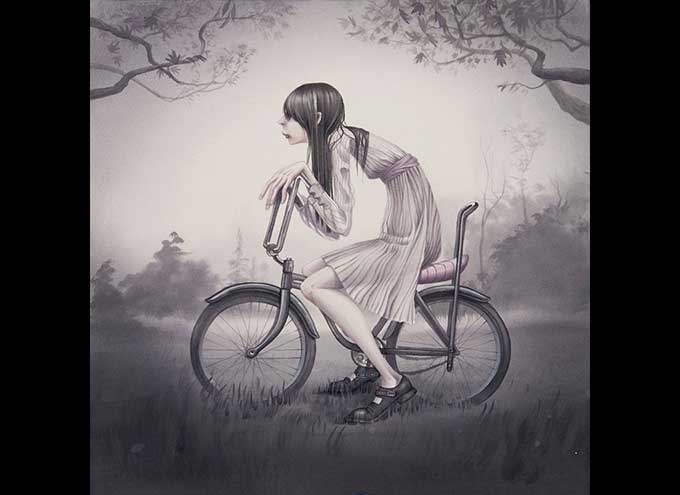via OUP Blog by Philip Goff

Abstract lights. Image by Little Visuals. Public domain via Pexels.
For most of the twentieth century a “brain-first” approach dominated the philosophy of consciousness. The idea was that the brain is the thing we really understand, through neuroscience, and the task of the philosopher is try to understand how that thing “gives rise” to subjective experience: to the inner world of colours, smells and sounds that each of us knows in our own case. This philosophical project has not gone all that well–nobody has provided even the beginnings of a satisfying solution to what David Chalmers called “the hard problem” of consciousness.
Continue reading
=============================
via the Guardian by Simon Jenkins
Who cares if, as a sensational new book argues, the painter traced and copied to achieve his effects? What matters is that the end results were sublime

Detail from Johannes Vermeer’s Girl with a Pearl Earring. Photograph: Mauritshuis, The Hague
Johannes Vermeer was a cheat. He was a printmaker, a tracer, a copyist. Some might say he was not a real artist at all. So suggests Jane Jelley in a new book, Traces of Vermeer, on the Dutch master. It is borderline sensational.
I was once a Vermeer groupie. I fell in love with his painting The Guitar Player when it was briefly stolen from Kenwood House in Hampstead, and set out to discover who this perplexing girl might have been. I hunted down almost all the 36 (or so) Vermeers across Europe and America, and corresponded with the Vermeer pundits John Michael Montias and Arthur Wheelock. In 2004 I went with Tracy Chevalier, author of the delightful novel Girl with a Pearl Earring, to open the bidding in the Sotheby’s auction of the last painting to be attributed to Vermeer – and endured an agonising few seconds until a next bid came in.
=============================
The haunting art of Annie Owens
via Boing Boing by Sarina Frauenfelder

Artist Annie Owens’ exhibition titled “A Place Worth Knowing” will be on display at La Luz De Jesus gallery in LA from August 4th-28th. If you can’t make it to the gallery, you should definitely check out her work on her website here.
Annie’s watercolor paintings are delicately haunting. They simultaneously look like antique photographs and scenes out of an eerie fantasy world. Her work features desolate landscapes and floating houses. The women in her paintings are isolated, ghostlike, and almost appear to be translucent.
Continue reading
=============================
A Bizarre Peace Proposal: Slice Europe Up Like a Pie
via Big Think by Frank Jacobs

A unified Germany is both too big to be a ‘normal’ European country, and too small to conquer the entire continent. Its power must be dissolved in a supranational structure – which will be all the more powerful by having Germany at its centre.
That’s solving a problem by turning it into a paradox. It could be a shorthand definition of the European Union. But the EU, which grew out of the European Coal and Steel Community (°1951), was not the first such proposal.
Here’s an extraordinary suggestion to prevent future conflict in Europe, proposed shortly after the end of the First World War. The 1920 map, in German, envisions a new Europe with lasting peace (Das neue Europa mit dem daurenden Frieden), via the means of political unification of Central Europe (Die Unionisierung Mitteleuropas).
The bulk of the European mainland would be united in a unitary state, governed from Vienna, renamed Unionshauptstadt Sankt Stephan (Union Capital St. Stephen). In this Union, there would be no place for 'traditional' member states as they had emerged from history, or could be construed by linguistic, ethnic or religious affiliation. It would do away with the traditional states of Europe. Instead, it would be sliced as a pie into 24 straight-bordered cantons radiating from the capital, all purposely ignoring the continent's variety of languages, religions and peoples.
Continue reading
=============================
via 3 Quarks Daily: Rafia Zakaria in The Baffler
On the second grim Friday following President Donald Trump’s victory in the November elections, I attended a Friday service at the Women’s Mosque of America. Held at a community center in Los Angeles, the service was organized entirely by a group of women seeking to further women’s leadership within the American Muslim community. Unlike other mixed mosque congregations, women deliver the call to prayer, they give the sermon, they set up and they pick up, they talk and they pray. We did all of those things that day; we also worried and cried and listened to announcements about self-defense classes—very important, the speaker emphasized, given recent developments. I left both drained and heartened, feeling at once unsure of an America mired in Islamophobia and yet hopeful for an American Muslim community led by women. Could the two co-exist, I wondered? How long before the demands of survival as American Muslims wipe out the efforts of resisting patriarchy as American Muslim women?
Continue reading
=============================
via the Guardian by Agence France-Presse
Site unearthed on land awaiting construction of housing complex is labelled an ‘exceptional find’ by culture ministry

An archaeologist works on a mosaic on the archaeological antiquity site of Sainte-Colombe, near Vienne. Photograph: Jean-Philippe Ksiazek/AFP/Getty Images
A “little Pompeii” is how French archaeologists are describing an entire ancient Roman neighbourhood uncovered on the outskirts of the southeastern city of Vienne, featuring remarkably preserved remains of luxury homes and public buildings.
“We’re unbelievably lucky. This is undoubtedly the most exceptional excavation of a Roman site in 40 or 50 years,” said Benjamin Clement, the archaeologist leading the dig on the banks of the Rhone river, about 18 miles (30km) south of Lyon.
Continue reading
=============================
via Arts & Letters Daily: Ruth Bernard Yeazell in New York Review of Books
Imitation has long had a bad rap, especially among spokesmen for modern art. “Immature poets imitate; mature poets steal”: T. S. Eliot’s often-cited dictum on the subject doesn’t pretend that poets get nothing from their predecessors, but it certainly implies that owning up to the debt is a sign of inferiority. The aggression implicit in the theft is presumably justified by the results—the mature poet takes what he likes and makes it his, by which point its origins matter less than what he has done with it. (The masculine pronoun here is deliberate.) There is something weakly concessive, on the other hand, about imitation, an apparent acknowledgment that the earlier poet has aesthetic priority too. Eliot stops short of saying, with Ralph Waldo Emerson, that “imitation is suicide,” but he makes it hard to imagine that any artist, particularly in a post-Romantic age, would call attention to the practice. Why risk being classified as a mere imitator?
Continue reading
=============================
via Boing Boing by Cory Doctorow

Phil Agre’s 1996 article “How to help someone use a computer” is full of eternal verities that hold up today: it starts with a section on putting yourself in the mindset of someone who’s struggling with something you know how to do already (“Beginners face a language problem: they can’t ask questions because they don’t know what the words mean, they can’t know what the words mean until they can successfully use the system, and they can’t successfully use the system because they can’t ask questions”) and then moves on to practical tips for turning that empathy into successful advice (“Try not to ask yes-or-no questions. Nobody wants to look foolish, so their answer is likely to be a guess. ‘Did you attach to the file server?’ will get you less information than ‘What did you do after you turned the computer on?’.”)
Continue reading
=============================
via the Guardian by Jeremy Hance for Ensia
They are one of the harshest environments on the planet and also one of the most important in terms of carbon storage. New research hopes to reveal the role these threatened bogs could play in the climate change story

Cutting edge research is being conducted in the Marcell Experimental Forest in northern Minnesota into how peatlands may react to our warming world. Photograph: Courtesy of Oak Ridge National Laboratory
Randy Kolka hands me a fist-sized clump of brownish-black material pulled up by an auger from a bog. It’s the color and texture of moist chocolate cake. When I look closely I can see filaments of plant material. This hunk of peat, pulled from two meters (7ft) below the surface, is about 8,000 years old. I’m holding plants that lived and died before the Egyptians constructed the pyramids and before humans invented the wheel. In my hand is history. And carbon gold.
Continue reading
=============================
via Flavorwire by Michelle Dean
First things first: the history of the novel is already tangled up with the notion of “trash.” Peruse the great 19th-century realist novels – particularly Jane Austen’s, say – and you’ll catch characters insulting each other’s reading habits. But there are a lot of reasons to read other than intellectual elevation. Relaxation is one; keeping up with what everyone else is reading is another. Here are 40 of the greatest trashy books written in the last hundred years that, if you’re not looking for perfect prose, will surely decrease muscle tension over a weekend, or on vacation. These books aren’t perfect, but each has some kind of hook – either unexpectedly good construction, entertainingly inventive salaciousness, or historical import in and of itself. Enjoy!
Peyton Place by Grace Metalious
Zoya by Danielle Steel
My Sweet Audrina by V.C. Andrews
Lace by Shirley Conran
Scruples by Judith Krantz
The Plains of Passage by Jean Auel
The Best of Everything by Rona Jaffe
The Carpetbaggers by Harold Robbins
Valley of the Dolls by Jacqueline Susann
The Thorn Birds by Colleen McCullough
The Lord Won’t Mind by Gordon Merrick
The Other Side of Midnight by Sidney Sheldon
Riders by Jilly Cooper
Delta of Venus by Anais Nin
The Second Lady by Irving Wallace
The Black Moth by Georgette Heyer
Lady Chatterly’s Lover by D.H. Lawrence
The Witching Hour by Anne Rice
Hollywood Wives by Jackie Collins
Bling by Erica Kennedy
Loves Music, Loves to Dance by Mary Higgins Clark
Comes the Blind Fury by John Saul
Strangers by Dean Koontz
The Silence of the Lambs by Thomas Harris
The Stepford Wives by Ira Levin
The Bad Seed by William March
A Season in Purgatory by Dominick Dunne
The Mists of Avalon by Marion Zimmer Bradley
Naked Came the Stranger by “Penelope Ashe”
Gone With the Wind by Margaret Mitchell
Outlander by Diana Gabaldon
The Stand by Stephen King
Shogun by James Clavell
God’s Little Acre by Erskine Caldwell
Go Ask Alice by “Anonymous”
Wifey by Judy Blume
Pillars of the Earth by Ken Follett
Queenie by Michael Korda
Beulah Land by Lonnie Coleman
Hawaii by James A. Michener
Go here to read the brief “what it’s about” on each of the books
I have read only six of these and enjoyed five!
No comments:
Post a Comment